Cold fog hangs white like muslin over the Juneau morning, masking the waters of the Taku River. To the Native Tlingit, "taku" is "salmon." The river has long been central to the lives of people here and it's one of the most important salmon fisheries in the world. An hour bush flight up the watershed runs the glacier-fed Tatsatua River. This stream is known by few. And, the salmon are plentiful, gorgeous, and gear-busting big.
"Let's try it," says my bush pilot Denis. Ahead stands the Coastal Mountain range, the Stikine Ice Fields, goats and grizzlies, and pristine North American wilderness. He hands me earplugs and stows an overnight bag and a sat phone – just in case.
I strap into the co-pilot's seat and laugh at the prospect. The only switch in reach reads, "Do not turn off in flight." No worries there. Tick, tick, tick Denis flips a dozen switches. The growl of the single-prop de Havilland Beaver fills my chest. Denis looks over and nods. The prop blurs then disappears, pulling the floats through the chop and then skimming the river's surface. We are up and catching half-glimpses of the wilderness below. The thickening curtain forces us downward. We fly the river toward Tatsamenie Lake where I hope to rendezvous with the largest Pacific salmon, the chinook, oncorhynchus tshawytscha: the king.
It's mid-August. King, coho, and sockeye are on the last 30-day leg of a life's journey. They're slipping from the Pacific into the Taku, pushing up the Sheslay, and bullying up the current and stony falls of the Tatsatua toward their spawning grounds.
For me, this is a trip of firsts. It's my first floatplane and on my first salmon trip I'm one of the first anglers to fish this run. Sure, I fly fish. But, I'm a hot water guy. I grew up pulling bass from cow ponds on fiberglass rods and Styrofoam poppers. I learned the roll cast by trying to get poorly tied mayflies to Red Creek sunnies. And, while one of my favorite pastimes is sight-casting flies to skinny water reds, I'll fish with hand-lines and hammers if need be.
Soon we're skating across the lake to camp on Greg Williams's johnboat and rabbit-hounding beagle Tuffy is riding the bow. Greg is the guide for non-residents on a 5- million-acre roadless wilderness. Today, he has hunters on the mountains; but I'm one of two anglers. The other is renowned conservationist Shane Mahoney. At camp, Shane and Greg explain their partnership in Wild Forever Alliance, a membership organization that funds conservation and makes wilderness hunts accessible to average people. I'm intrigued and eventually I sign up, but for now I'm itching to fish.
I sneak off, assemble my spinning gear, and get to the river as soon as I think can pull it off without being rude. Yeah thanks for having me, where's the damn pie! I zing an in-line spinner bait across a crystal backwater. A red blur swoops in. I set the hook. First cast. Yes. No hammers necessary. I wrestle it in, remove the hook, and admire the 12-pound sockeye. She swims away. Awesome. First sockeye. That'll hold me over until tomorrow.
The 9 p.m. sun hangs low. We all sit on the hand-hewn porch and talk traditions and conservation. We watch a moose swim the lake. And, we talk fish.
"The streams are full of salmon and trout. They grow big here," Greg says "and no one fishes them."
In the morning, that'll change.
First Fly Cast
At 5:55 a.m. sunrise glares from a snowy peak and lures me from my bunk. At 6:15 I'm crouched in the dew-wet grass. Fog sits the river and hides the spruce. The glacial water runs fast, cold, and gin clear along a roller coaster track of gravel and sand, peaking high near the surface and scooping into holes. In hydraulic pockets and seams across the river, big salmon lay in stacks as red and tight as bricks.
I tie on a big Dolly Llama fly and cast up and across stream. The cone head drags the strips of rabbit fur down through the water column. The current sweeps the fly along, bouncing it across gravel and sand, tinsel shining, furry strips dancing burlesque. Everything about the fly is meant to aggravate the hell out of big salmon.

It tails out and disappears. The line sucks sheoooo when I set the hook. The fight's on. In time, a dark mottled red coho comes to the bank. At 10 pounds or so, my first coho is no giant, but she's a fine fish. She swims off to finish her journey and lay her 2,500 eggs.
A rule of fishing is don't leave fish to find fish. But I do. I'm looking for kings. I ease along, studying the water and swinging the big fly.
A meaty rainbow slams the fly, cuts somersaults, launches three feet into the air in a water-slinging flail and gives me every bit of hell he can muster. A 21-inch rainbow with balls enough to bust a king salmon fly and put a deep bend on a 9-weight rod is something to experience – and a first for me.
Kings Court
7:20 a.m. I spot them and freeze. Dark, log-sized phantoms are resting off the main current and cruising in singles and pairs. One comes near and I'm doing math and hoping to get it right. If you've sight cast to redfish, you know what happens next. It's akin to shooting dove from a moving pickup.
Thirty feet upstream, 10 feet past him, I hope that'll drop the fly on his nose. His body flares. He bolts across the river. I'm dialed in tight. The fly disappears and his weight reminds me to set the hook. In half a second he's on. Pop, pop, pop the reel beats my knuckles and siiiiiings. He tears down stream. Back and forth he goes. He bursts out of the river, sails through the air, and crashes. Time after time. I try to turn his head toward the bank. I tighten the drag, hoping to push my luck, not break it. Ten minutes later he's at the bank. Swooosh he charges back out.
Everything stops. In slow motion my fly line pops free and sails out. Before I have time to consider flooded waders, I dive and manage to catch the line. I slosh to my feet, holding on for dear life with right hand and stripping line with my left. I'm begging the fishing Gods. He cinches the line tight into my hands. Then we play a strategic tug of war, testing tensile strength and angles.
He surfaces and alligator-rolls his thick body. He's huge. And, I think I've got him. I back up toward the bank. It's going to happen. Five minutes later and he's almost in. Woosh. He turns. Everything goes slack. He swims off.
I'd like to say I take it well. But I string together every slur, slander, and swear I can call up. I may have set free a man tear. Then I take it well. I slurp water from the river and wash my face. I study the broken hook and laugh at myself. Tomorrow.
Fresh baked bread and mountain goat stew is waiting when at the cabin. I'm sure no one will believe me; but I tell them about the big rainbow trout and the hook- breaking salmon. They all nod something like sounds about right.
"Yeah," says Greg, "biologists say our sockeye are 25% bigger here." The kings are huge, too. Tomorrow there'll be proof.
My eyes pop open at 5:45 a.m. I set the unverified Guinness Book world record for wader donning. I run-walk to the river, whistling to keep bears and elephants away. At 6:00 I'm fishing. I work down river catching good coho, kings, sockeye, and roughneck rainbows. But, I really want another chance at a beast.
Second chance
Tuffy's voice rings down the river. He's the only beagle in a valley full of rabbits. I can relate. Right now I'm likely the only one fishing a wilderness six times the size of the King Ranch and bigger than Delaware and Connecticut combined. My muscles ache from fighting fish. And, I think there's a shadow holding deep up ahead. After four or five swings, the dance of the pink and purple Dolly Llama gets a response.
The strike sucks out the slack. I strip set the hook and pull my hand from the reel after a couple of good raps. The fight is almost a carbon copy of yesterday, so I know he's big. But, the backing holds. I pray hard to the fishing gods and play him as long as I can stand it. Eventually I back from waist-deep water to the bank. When his dorsal breaks the surface, he turns and bolts into the current. Something pops cack. Everything goes limp. I've lost him. The 9-wt rod hangs in two. Shit. I should've pointed the rod and let the reel do the work. Weeen the drag sounds. He's still on. I jump and grab and again I'm hand lining.

For the next 15 minutes or so, I strip line, pray, tangle myself, hope, run up and down the river, try Tibetan throat singing, churn out Gregorian chants, and otherwise do everything I can to not blow it. Finally, he tires and I bring him in. He's not as big as the one yesterday, but he's a 38" beast – by far the biggest fish I have ever landed on fly. I grip as far around his tail as I can and lift him by his thick, dark belly. The fly dangles pink from his olive head. I slip the hook out. It takes a minute for him to recover. And, me too, honestly. Eventually, he snaps to and eases back out to await his chance to spawn.
For several more weeks salmon will gather here. They'll sweep gravel clean and beat the hell out of anything that gets too close. They'll give short chase to the Rainbows and Dolly Varden that lay among them to feed on the eggs. Then the salmon will die.
The eggs will hatch. The tiny alevin will live in the gravel until they're big enough to take on the currents as fry. The strong fry will grow to smolts and turn downstream toward the Pacific. For up to five years, they'll cruise the seas and mature.
Next year, a new generation of spawning adults will move through the Taku and the Sheslay and bully up the Tatsatua. At Tatsamenie Lake, they'll stack tight as bricks and protect their redds with everything they have. The salmon will be there. I will too. And, I'm bringing a bigger rod.




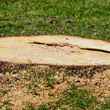
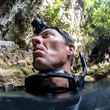



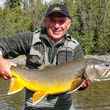



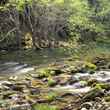
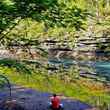



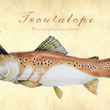
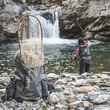



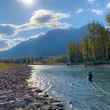
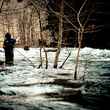



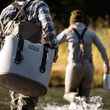

Comments